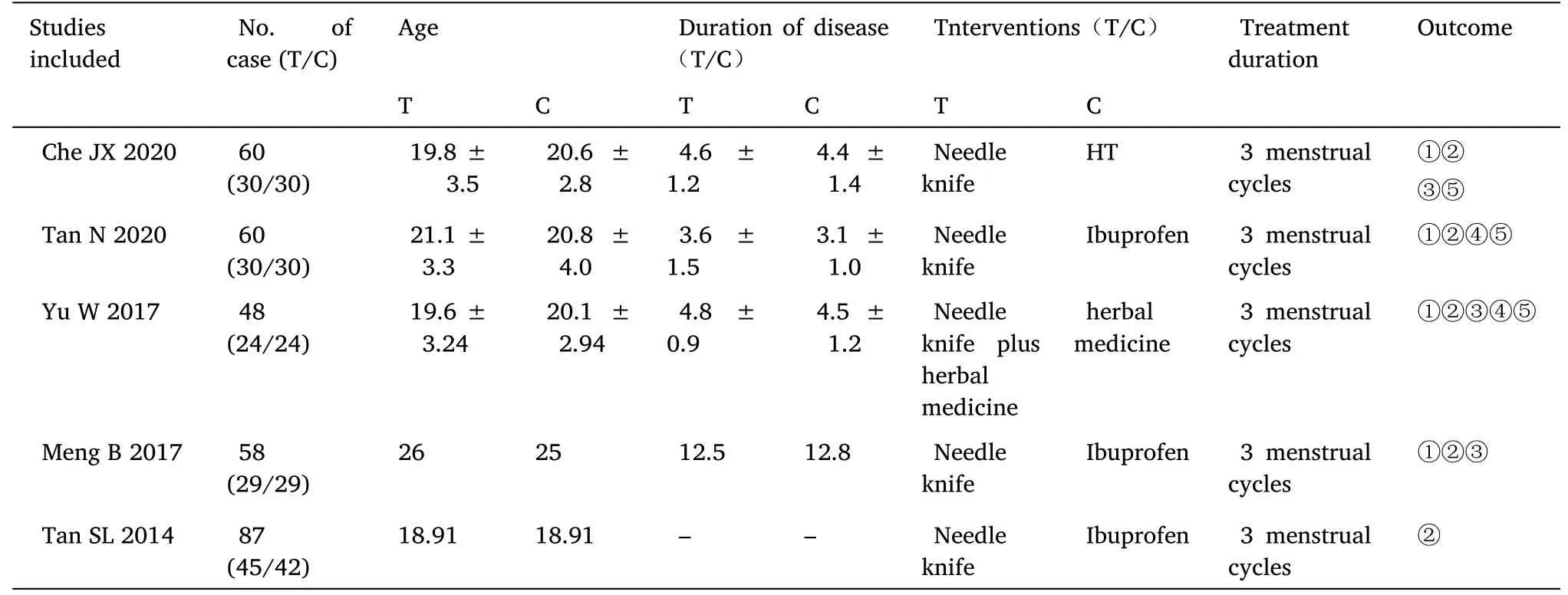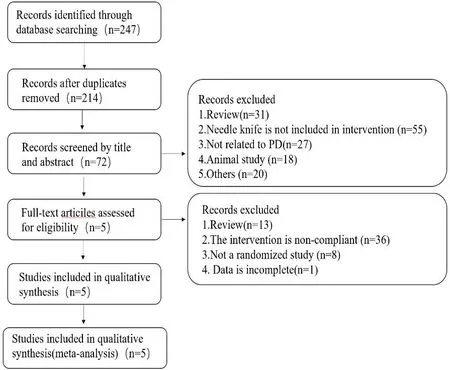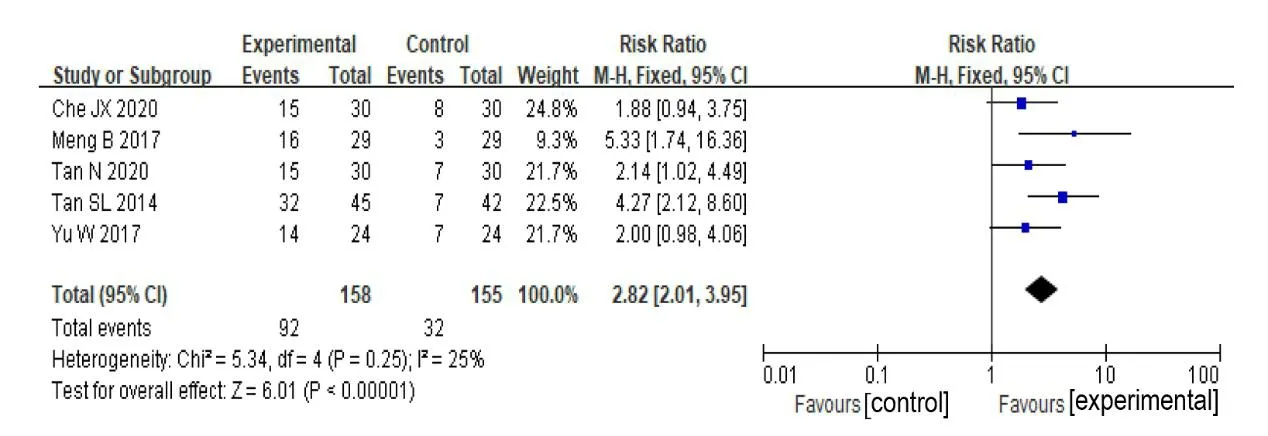Needle knife in the treatment of primary dysmenorrhea:a systematic review and meta-analysis
2022-10-14JiJuWangKeLiuDongMeiWangTianMinZhangLongFengHuChangMingChen
Ji-Ju Wang,Ke Liu,Dong-Mei Wang,Tian-Min Zhang,Long-Feng Hu,Chang-Ming Chen*
1Department of Obstetrics and Gynecology,Beijing Fengtai District Hospital of Chinese Medicine,Beijing 100071,China.2Teaching and Research Office of Acupotomology,Hubei University of Chinese Medicine,Wuhan 430065,China.
#Ji-Ju Wang and Ke Liu are the co-first authors of this paper.
Abstract Objective:The aim of this meta-analysis was to examine the effectiveness and safety of needle knives for primary dysmenorrhea.Methods:We searched the electronic databases from their inception to May 25,2022,comprising Cochrane Library,PubMed,Embase,SinoMed,CNKI,VIP and Wanfang databases.Randomized controlled trials(RCTs)investigating the effectiveness of needle knives for people with primary dysmenorrhea were eligible.The risk of bias and the quality of the included literature were evaluated.RevMan5.3 software was used for this study.Results:Five articles with 313 participants were involved in the review.The cure rate(2.82(2.01,3.95),I2=25%)and total effective rate(1.32(1.10,1.57),I2=65%)of the experimental group were higher than those of the control group.The dysmenorrhea symptom scores(-1.81(-2.61,-1.01),I2=69%),TCM symptom scores(-4.19(-6.06,-2.31),I2=0%)and adverse reactions(0.16(0.05,0.51),I2=0%)of the experimental group were lower than those of the control group.Conclusions:Needle knives may provide advantages in the treatment of primary dysmenorrhea.RCTs,including the larger sample,multi-center,high-quality and double-blind research,were required to further verify the efficacy of needle knives for primary dysmenorrhea.
Keywords:needle knife;primary dysmenorrhea;effectiveness;safety;meta-analysis
Introduction
Dysmenorrhea refers to lower abdominal pain and bulging in women during or before and after menstruation,which may be accompanied by other symptoms such as backache,nausea,and vomiting.Dysmenorrhea is one of the most common gynecological disorders in women,and the prevalence ranges from 17% to 81%.Women with long-term dysmenorrhea decreased their quality of life and increased anxiety and depression[1].Primary dysmenorrhea(PD)is defined as dysmenorrhea without structural changes[2].It was estimated that the proportion of patients with PD accounted for more than 90% of patients with dysmenorrhea,and up to 56.7% would suffer from disrupted daily work and lifestyle[3,4].
Drugs for pain relief include non-steroidal anti-inflammatory drugs,hormone therapy,calcium channel blockers,and pain relievers.Have been known as the most common therapy for PD[5].However,the effect of these drugs is unsatisfactory clinically,leading to many adverse effects.For example,non-steroidal anti-inflammatory drugs are widely used to alleviate pain,and it has also been used in treating PD.However,its effectiveness was inclusive.Hormone therapy is associated with liver and kidney dysfunction,weight gain,etc.Thus,alternative therapies with fewer harms and more benefits were in demand[6].
As an emerging discipline,acupotomology is developed from the disciplines of meridian,anatomy,and physical mechanics.Needle knife has been widely used to treat orthopedic diseases such as cervical spondylosis and lumbar spondylosis.Clinical studies on PD treated with needle knives have been increasingly reported[7-9].However,most of the research has a small sample size.Therefore,this study collected RCTs to evaluate the efficacy and safety of needle knives for PD.
Methods
Search strategy
This systematic review is conducted in accordance with the Preferred Items for Systematic Review and Meta-Analysis(PRISMA)for Systematic Reviews of Intervention[10].We searched the electronic databases from their inception to May 25,2022,including Cochrane Library,PubMed,Netherlands Medical Literature Database(EMbase),Chinese Journal Full-text Database(CNKI),China Biomedical Literature Database(SinoMed),VIP Chinese Scientific and Technological Periodical Database(VIP),Wanfang Academic Journal Full-text Database(Wanfang Data).The following search terms were used:“needle knife”,“acupotomology”,“acupuncture knife”,“needle knife therapy”,“PD”and“dysmenorrhea”.Language or publication status would not be restricted.The reference lists of included articles were manually searched to include any eligible studies.
Inclusion criteria
(1)Types of participants:women who were definitely diagnosed with PD met the inclusion criteria.(2)Types of interventions:the experimental group involved patients undergoing needle knives or a combination of needles and other therapies.The control group involved patients undergoing placebo,drug therapy and no-treatment.(3)Types of outcome measures:major outcome parameters include clinical cure rate,total effective rate,scores of dysmenorrhea symptom,scores of TCM symptom and adverse events.Total effective rate=(number of effective cases+number of markedly effective cases+number of cured cases)/total cases number*100%.TCM symptoms include pain in the lower abdomen,few or irregular menstrual flow,blood clots,fear of cold,pale complexion,dark tongue,and white coating.(4)Types of clinical research:RCT.
Exclusion criteria
We excluded these studies that were not RCTs designed.For repeated publications,only one article was selected for review;it was ineligible for the study if the data was insufficient,lacking,or unable to translate into an effective sort.
Data extraction and quality assessment
Searches were conducted,and data were extracted by two reviewers(Wang JJ and Liu K).Each trial identified in the study was evaluated for the design,patient inclusion criteria,and outcomes.Divergences were resolved by discussion with a third review reviewer(Chen CM).Duplicate records were excluded after the screening of titles and abstracts.All remaining articles were screened in full texts,and excel was used for statistical analysis.Two reviewers independently assessed the bias risk by using the cochrane collaboration’s tool[11].“Low risk”,“unclear”,or“high risk”was classified in each bias domain.
Statistical analysis
Review Manager software Version 5.3.0 was used.For continuous data,we used mean difference with 95% confidence intervals to present the therapeutic effect;for dichotomous data,we used relative risk(RR)with 95% confidence intervals.Heterogeneity was assessed by the chi-square test and the higginstest.If heterogeneity was low(<50% and>0.1),we used the fixed effects model.Otherwise,the random effect model was used if heterogeneity was high(>50% or<0.1).Pooled differences in means or ratio were calculated and a-value<0.05 was considered to indicate statistical significance.
Results
247 articles were found by database searching.214 articles were screened by reading the title/abstract after removing duplicates.After reading the full texts of the remaining 72 articles,5 trials were finally adopted in the systematic review[12-16].The study flow diagram summarized the screening process(Figure 1),and the characteristics of 5 involved trials were presented in Table 1.

Table 1 Characteristics of 5 studies in the literature search

Figure 1 Study flow diagram
Risk of bias in included studies
According to the risk assessment tool recommended by the Cochrane Handbook,the quality of the included 5 studies was evaluated[11].The risk of bias was summarized in Figures 2 and 3.For random sequence generation,3 trials used random number tables,and 2 trials did not provide details of randomization[12-16].Only one of the trials reported allocation concealment[14].The binding of participants,personnel,and outcome assessors was not applied in any studies.None of the studies had attribution bias.The risk of bias in selective reporting was unclear as none of the studies published their protocols.

Figure 2 Graph of risks of bias

Figure 3 Summary of risks of bias
Clinical cure rate
Five RCTs applied the clinical cure rate in outcome measurement[12-16].A fixed-effect model of analysis was adopted,as statistical heterogeneity had not been detected(=25%,=0.25).The overall meta-analysis showed needle knife therapy for PD was superior to control therapy(=2.82,95%2.01-3.95<0.00001)(Figure 4).
Total effective rate
A total of 5 studies investigated the total effective rate of the needle knife group compared with the control group for the treatment of PD[12-16].There was statistical heterogeneity among five studies(=65%,=0.02).Therefore,the random effect model was used for analysis.The results showed that needle knife therapy improved the total effective rate with a statistically significant difference(=1.32,95%1.10-1.57=0.002)(Figure 5).
Dysmenorrhea symptom scores
Three RCTs measured the effectiveness of a needle knife for PD by using dysmenorrhea symptom scores[13-16].Three studies were pooled with heterogeneity(I=69%,=0.04).Meta-analysis showed needle knife was more effective than control therapy(=-1.81,95%-2.61--1.01=0.04;random model)(Figure 6).
TCM symptom scores
Only 2 studies measured the effectiveness of needle knives for PD using TCM symptom scores,and there was not pronounced heterogeneity among the studies(=0%,=0.04)[12,14].The fixed effect model was used for analysis,and the results showed that the needle knife group was more effective than the control group(=-4.19,95%-6.06--2.31<0.0001).See Figure 7.
Adverse events
Adverse events were monitored in 3 studies[13,14].The heterogeneity among the studies was not pronounced(=0%,=0.64),and we adopted the fixed effect model.Meta-analysis showed that the incidence of adverse events in the group of needle knives was less than in the control group(=0.16,95%0.05-0.51=0.002)(Figure 8).
Publication bias
The funnel plots of clinical cure rates were asymmetrical.As shown in Figure 9,the shape of the funnel plot is asymmetrical,suggesting the presence of publication bias.

Figure 4 Meta-analysis for clinical cure rate

Figure 5 Meta-analysis for total effective rate

Figure 6 Meta-analysis for dysmenorrhea symptom scores

Figure 7 Meta-analysis for TCM symptom scores

Figure 8 Meta-analysis for adverse events

Figure 9 The funnel plots of clinical cure rate
Discussion
Summary of major results
In the present study,we reviewed 5 RCTs involving 313 participants and assessed the effects and safety of needle knife therapy in women with PD.Meta-analysis showed that a needle knife was more effective in treating PD.In addition,the incidence of adverse events in the participants treated with needle knife therapy was less than in control therapy.However,the risk of bias in the included RCTs may affect the evidence certainty;most studies did not blind the participants or personnel.
Possible explanations for the evidence
In acupotomology,the causes of PD are as follows:first,the chronic injury of the soft tissue around the spine causes spasm of the lumbar soft tissue,leading to dislocation of the lumbar spine,resulting in the compression of the lumbar plexus and abnormal sensation in the innervated area of the lumbar plexus,causing low back pain,lower abdominal pain,etc.;the second is the dysfunction of the uterus and appendages caused by uterine dislocation.The ligaments that maintain the normal position of the uterus and its appendages mainly include uterine round ligament,broad ligament,cardinal ligament,and uterosacral ligament,which are directly or indirectly attached to the spine or pelvis.When the spine and the soft tissues around the pelvis are chronically injured,the spine and pelvis are dislocated,and the ligaments that connect and fix the uterus are pulled,resulting in the dislocation of the uterus and its appendages.The pelvic cavity is rich in nerves and blood vessels.The pelvic plexus is mainly derived from the parasympathetic nerve fibers of S2,S3,and S4.When the uterus is abnormally positioned,the nerves and blood vessels in the ligaments are compressed,and the pelvic cavity is congested and edema before and after menstruation.Symptoms of stress can lead to the accumulation of metabolites such as PGE2,which in turn cause the dysfunction of the uterus and appendages to further induce
dysmenorrhea.Needle knife therapy can release the adhesions,scars,and contractures formed by soft tissue injuries around the lumbosacral and pelvis,relieve the compression of the lumbar plexus,disperse the abnormal relay that connects and fix the uterine ligaments,restore the dislocation of the uterus and its appendages,and block pathological mechanism of PD[17,18].
Limitations and implications of the research.
There were several limitations in this research.Above all,the quality of the detailed studies was poor.The risks of reporting bias and selection bias were mostly unclear.Secondly,the risk of performance bias was unclear.As we all know,these biases may affect the meta-analysis results.Thirdly,we found heterogeneity across this research.This can also reduce the evidence certainty.In addition,none of the RCTs included considered stimulation to simulate a needle knife as the control.Finally,the small sample size seemed to be the problem for this meta-analysis,which does not provide strong evidence in favor of needle knife therapy.
Conclusion
The findings suggest that needle knife therapy may benefit women with PD.More RCTs with a rigorous design,particularly applying stimulation to simulate a needle knife as the control and blinding the participants and personnel,are needed to confirm the efficacy of a needle knife for PD.
